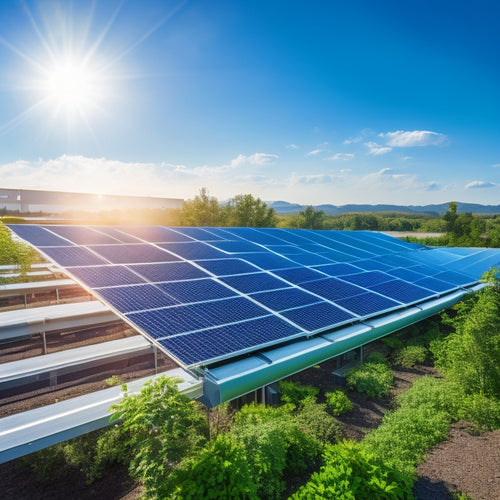
Optimizing Warehouse Rooftop Space With Solar Power
Share
By harnessing your warehouse rooftop space for solar power, you can greatly reduce energy costs and boost property value. To get started, assess your rooftop's structural integrity, available space, and obstacles like skylights or vents. Evaluate your energy consumption patterns, including peak hours and daily rhythms, to optimize energy usage. Next, select suitable solar panels and design a layout that maximizes energy output. As you consider the various factors, you'll uncover opportunities to increase energy production and revenue potential - and that's just the beginning of optimizing your warehouse rooftop space with solar power.
Key Takeaways
• Analyze rooftop space constraints, including structural integrity, available space, and existing obstacles to optimize solar panel placement.
• Assess energy consumption patterns to identify peak hours, optimize energy usage, and mitigate grid strains.
• Select suitable solar panel types considering panel efficiency, thermal performance, and compatibility with the rooftop.
• Design the solar array to maximize energy output by considering azimuth angle, tilt angle, and shading analysis.
• Ensure structural integrity compliance by evaluating rooftop support capacity, conducting load calculations, and complying with local building codes.
Assessing Rooftop Space Constraints
When evaluating your warehouse rooftop's suitability for solar power, begin by analyzing the physical constraints that may impact the installation, including structural integrity, available space, and existing obstacles such as skylights, vents, or HVAC equipment.
Evaluating rooftop accessibility is vital, as it directly affects the installation process and maintenance requirements. Make sure you have sufficient clearance for workers and equipment to access the rooftop safely.
Structural limitations, such as load-bearing capacity and roof orientation, must also be considered to ensure the solar panels are securely fastened and optimized for energy production.
A thorough examination of these constraints will help you determine the feasibility of a rooftop solar installation and inform your decision-making process.
Evaluating Energy Consumption Patterns
As you evaluate your warehouse's energy consumption patterns, you'll want to identify your peak energy hours, which are typically during weekdays when operations are in full swing.
You'll also need to examine your energy usage patterns, including daily and monthly fluctuations, to determine how they impact your overall energy consumption.
Peak Energy Hours
You can identify peak energy hours by analyzing your facility's energy consumption patterns, which typically reveal a daily rhythm of high and low usage periods. This analysis helps you understand when your energy demands are highest, often coinciding with peak operating hours, lunch breaks, or equipment-intensive processes. By pinpointing these peak hours, you can:
-
Optimize energy usage: Shift non-essential tasks to off-peak hours, reducing strain on the grid.
-
Mitigate grid strains: Reduce your facility's energy demands during peak hours, alleviating pressure on the grid.
-
Schedule maintenance: Plan maintenance and repairs during off-peak hours, minimizing energy consumption.
- Maximize solar power integration: Align your solar power generation with peak energy hours, maximizing its impact on your energy demands.
Energy Usage Patterns
Your facility's energy usage patterns can be evaluated by analyzing its consumption data. This typically reveals a unique rhythm of high and low energy usage periods throughout the day. By examining these patterns, you can identify opportunities to optimize energy consumption and reduce peak demand charges.
Energy profiling is an important step in this process, as it helps you understand your facility's energy usage habits. Load forecasting is another essential tool, allowing you to predict energy usage patterns and make informed decisions about energy management.
Seasonal Consumption Trends
Seasonal fluctuations in temperature and daylight hours greatly influence your facility's energy consumption patterns, causing peak demands to shift throughout the year. Winter fluctuations lead to increased energy consumption for heating, while Summer spikes occur due to cooling demands. Understanding these seasonal trends is essential for optimizing your energy usage.
Here are some key factors to keep in mind:
-
Winter peak demand: Heating systems consume more energy during extreme cold snaps.
-
Summer peak demand: Cooling systems work harder during heatwaves.
-
Shoulder season opportunities: Milder weather during spring and fall can reduce energy consumption.
- Daylight savings impact: The time change can affect your facility's energy usage patterns.
Selecting Suitable Solar Panel Types
When selecting suitable solar panel types for your warehouse rooftop, you'll need to take into account the panel efficiency ratings, which can range from 15% to over 20%.
You'll also need to think about the mounting system options, including fixed-tilt, single-axis, and dual-axis tracking systems.
Panel Efficiency Ratings
Selecting the right solar panel type for your warehouse rooftop hinges on understanding panel efficiency ratings, which vary considerably between brands and models, with top-tier options boasting efficiencies up to 23%.
As you evaluate options, consider the following key factors that impact panel efficiency:
- Thermal performance: How well a panel converts sunlight into energy in high-temperature conditions.
- Energy conversion: The percentage of sunlight that's converted into usable electricity.
- Reflectance: The amount of sunlight reflected rather than absorbed by the panel.
- Temperature coefficient: How efficiently a panel generates energy as temperatures rise.
Mounting System Options
You'll need to select from a range of mounting system options, each suited to specific solar panel types, to guarantee a secure and efficient installation on your warehouse rooftop.
Rail systems are a popular choice, offering a versatile and adjustable solution for various panel sizes.
Clamp designs, on the other hand, provide a more customized fit, ensuring a snug and secure attachment to the rooftop.
When selecting a mounting system, consider factors such as wind load, snow load, and roof type to ensure compliance with local building codes.
It's crucial to choose a system that complements your solar panel type, promoting efficient energy harvesting and minimizing potential risks.
Designing for Optimal Energy Output
To maximize energy production, take into account the orientation and tilt of your solar panels, as these factors greatly impact the overall energy output of your rooftop solar installation. A well-designed system ensures peak energy output, and it's essential to take into account the following:
-
Azimuth angle: Make sure your panels face the best direction to capture maximum sunlight.
-
Tilt angle: Adjust the tilt to match your location's latitude for ideal energy harvesting.
-
Shading analysis: Identify potential shading obstacles to minimize energy losses.
- Panel layout: Strategically arrange panels to maximize energy output while considering aesthetic integration and energy modeling.
Ensuring Structural Integrity Compliance
Before installing solar panels, your warehouse rooftop must be evaluated to confirm it can support the added weight and wind resistance of the solar array, thereby guaranteeing structural integrity compliance.
You'll need to conduct load calculations to determine the maximum weight your rooftop can handle. This involves appraising the existing roof's load-bearing capacity, taking into account factors like snow, wind, and dead loads.
Additionally, you must comply with local building codes, which dictate the minimum requirements for structural integrity. By doing so, you'll ascertain your rooftop can safely support the solar array, avoiding potential risks and liabilities.
Proper evaluation and compliance will give you peace of mind, knowing your solar installation is secure and efficient.
Maximizing Rooftop Space Utilization
By optimizing rooftop space utilization, you can fit more solar panels on your warehouse roof, increasing energy production and revenue potential while minimizing installation costs. This is essential for warehouse owners seeking to maximize their rooftop's potential.
To achieve this, consider the following strategies:
-
Rooftop Expansion: Expand your rooftop area by using cantilevered or elevated structures to increase the surface area available for solar panels.
-
Warehouse Aesthetics: Guarantee that the solar panel installation complements the warehouse's architectural design, maintaining a visually appealing exterior.
-
Panel Orientation: Optimize panel orientation to maximize energy production, taking into account the warehouse's location and surrounding environment.
- Space-Efficient Design: Implement a space-efficient design that minimizes gaps between panels, reducing wasted space and increasing overall energy output.
Mitigating Shade and Obstruction
Shading from surrounding structures or rooftop obstructions can greatly reduce solar panel energy output, but you can minimize these losses by strategically positioning panels to capture ideal sunlight. To mitigate shade, you'll need to analyze your building's orientation and surrounding environment. Consider tree pruning strategies to reduce foliage obstruction, and assess potential shading from adjacent buildings or rooftop equipment.
Conduct a thorough building orientation analysis to identify the best panel placement, taking into account the sun's path across the sky. By strategically positioning your solar panels, you can maximize energy output and minimize losses due to shade and obstruction.
Monitoring and Maintenance Strategies
To guarantee peak performance and extend the lifespan of your solar panel system, you'll need to implement a thorough monitoring and maintenance strategy that tracks energy output, identifies potential issues, and schedules regular inspections and repairs. This proactive approach secures your system operates at peak levels, minimizing downtime and maximizing energy production.
To achieve this, consider the following key aspects of a monitoring and maintenance strategy:
-
Performance tracking: Regularly monitor energy output to identify deviations from expected performance.
-
System audits: Conduct routine inspections to identify potential issues before they become major problems.
-
Scheduled maintenance: Plan regular maintenance activities, such as cleaning and replacing components, to prevent issues.
- Data analysis: Analyze performance data to identify opportunities for optimization and improvement.
Incentives and ROI Analysis
When evaluating the financial viability of your solar panel system, you'll want to calculate the return on investment (ROI) and explore available incentives that can greatly offset the upfront costs.
Federal and state governments offer various tax benefits, such as the Solar Investment Tax Credit (ITC), which can provide significant savings. You'll want to factor in these tax benefits when creating financial projections for your solar panel system.
A thorough ROI analysis will help you determine the payback period and estimate the overall financial performance of your investment. By considering these incentives and projecting your returns, you'll be better equipped to make informed decisions about your solar panel system and maximize your ROI.
Frequently Asked Questions
Can Existing Rooftop HVAC Units Be Relocated for Solar Panel Installation?
'You'll need to assess your rooftop's layout through detailed mapping to determine if existing HVAC units can be relocated for solar panel installation, considering refurb options for compatibility and best placement.'
How Do I Ensure Solar Panels Won't Interfere With Rooftop Drainage Systems?
To guarantee solar panels won't interfere with rooftop drainage systems, you'll need to maintain proper Drainage Clearance and conduct a thorough Waterflow Analysis to identify potential obstructions, ensuring unimpeded water flow and preventing water accumulation.
Are There Any Specific Solar Panel Installation Requirements for Seismic Zones?
You face an important consideration: seismic zones. Did you know 75% of the US population lives in areas prone to earthquakes? Guarantee zone compliance by following local building codes, anchoring panels securely, and selecting seismic-rated racking systems to mitigate seismic risk.
Can I Install Solar Panels on a Rooftop With a Low Load-Bearing Capacity?
You'll need to assess the rooftop's load-bearing capacity before installing solar panels; consider structural reinforcement or roof reinforcement to guarantee the rooftop can support the added weight, then consult with an engineer to determine feasibility.
Do Local Building Codes Allow for Rooftop Solar Panels on Historic Buildings?
"Like a master puzzle solver, you'll navigate local building codes, ensuring historic preservation doesn't clash with rooftop solar ambitions. You'll need building permits, so research and comply with local regulations to seamlessly integrate solar panels into historic buildings."
Related Posts
-

Renewable Energy Certifications for Businesses
Renewable energy certifications are essential for your business, showcasing your commitment to sustainability and enh...
-

Solar Energy Efficiency Improvements for Businesses
Improving solar energy efficiency for your business can lead to considerable cost savings and enhance your sustainabi...
-

Green Energy Alternatives for Independent Living
To enhance your independent living, consider green energy alternatives like solar panels and wind turbines. These opt...


